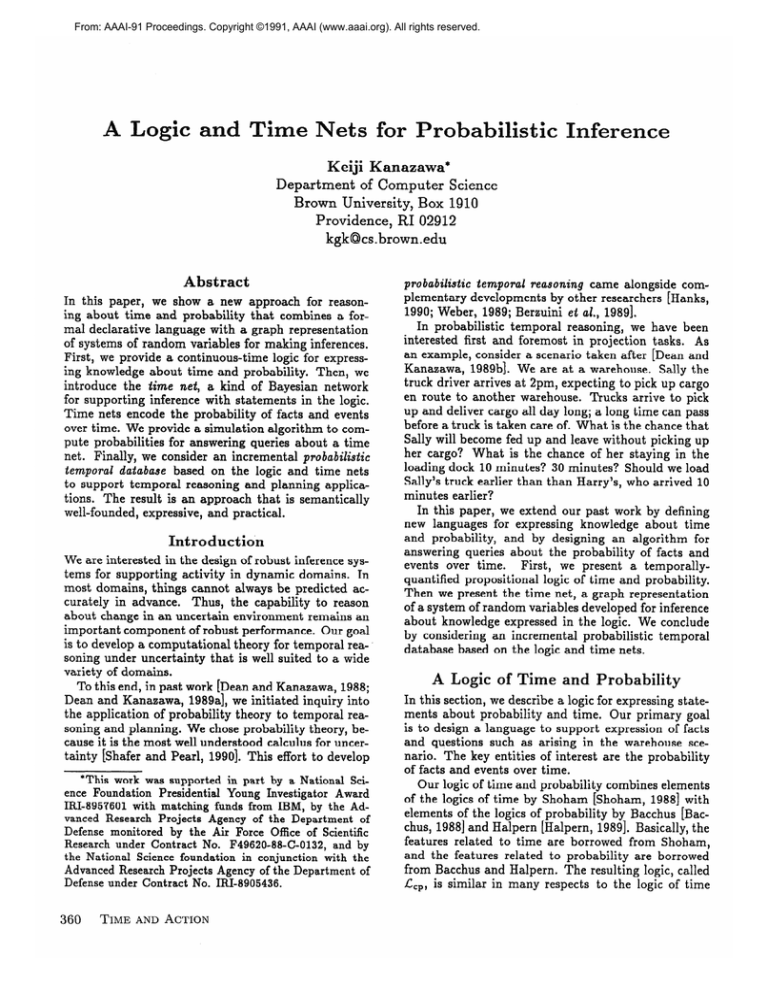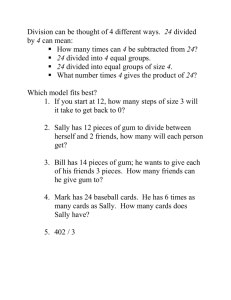
From: AAAI-91 Proceedings. Copyright ©1991, AAAI (www.aaai.org). All rights reserved.
A Logic and Time Nets for Probabilistic
Inference
Keiji Kanazawa*
Department of Computer Science
Brown University, Box 1910
Providence, RI 02912
kgk@cs.brown.edu
Abstract
In this paper, we show a new approach for reasoning about time and probability
that combines a formal declarative language with a graph representation
of systems of random variables for making inferences.
First, we provide a continuous-time
logic for expressing knowledge about time and probability.
Then, we
introduce the time net, a kind of Bayesian network
for supporting inference with statements in the logic.
Time nets encode the probability
of facts and events
over time. We provide a simulation algorithm to compute probabilities
for answering queries about a time
net. Finally, we consider an incremental probabilistic
temporal database based on the logic and time nets
to support temporal reasoning and planning applications. The result is an approach that is semantically
well-founded, expressive, and practical.
Introduction
We are interested in the design of robust inference systems for supporting activity in dynamic domains.
In
most domains, things cannot always be predicted accurately in advance.
Thus, the capability to reason
about change in an uncertain environment remains an
important component of robust performance.
Our goal
is to develop a computational
theory for temporal reasoning under uncertainty that is well suited to a wide
variety of domains.
To this end, in past work [Dean and Kanazawa, 1988;
Dean and Kanazawa, 1989a], we initiated inquiry into
the application of probability theory to temporal reasoning and planning. We chose probability theory, because it is the most well understood calculus for uncertainty [Shafer and Pearl, 19901. This effort to develop
*This work was supported in part by a National Science Foundation Presidential Young Investigator Award
IRI-8957601 with matching funds from IBM, by the Advanced Research Projects Agency of the Department of
Defense monitored by the Air Force Office of Scientific
Research under Contract No. F49620-88-C-0132,and by
the National Science foundation in conjunction with the
Advanced Research Projects Agency of the Department of
Defense under Contract No. IRI-8905436.
360
TIME AND ACTION
probabilistic temporal reasoning came alongside complementary developments by other researchers [Hanks,
1990; Weber, 1989; Berzuini et al., 19891.
In probabilistic
temporal reasoning, we have been
interested first and foremost in projection
tasks. As
an example, consider a scenario taken after [Dean and
Kanazawa, 1989b]. We are at a warehouse. Sally the
truck driver arrives at 2pm, expecting to pick up cargo
en route to another warehouse. Trucks arrive to pick
up and deliver cargo all day long; a long time can pass
before a truck is taken care of. What is the chance that
Sally will become fed up and leave without picking up
her cargo? What is the chance of her staying in the
loading dock 10 minutes? 30 minutes? Should we load
Sally’s truck earlier than than Harry’s, who arrived 10
minutes earlier?
In this paper, we extend our past work by defining
new languages for expressing knowledge about time
and probability,
and by designing an algorithm for
answering queries about the probability
of facts and
events over time.
First, we present a temporallyquantified propositional
logic of time and probability.
Then we present the time net, a graph representation
of a system of random variables developed for inference
about knowledge expressed in the logic. We conclude
by considering an incremental probabilistic
temporal
database based on the logic and time nets.
A Logic of Time
and Probability
In this section, we describe a logic for expressing statements about probability and time. Our primary goal
is to design a language to support expression of facts
and questions such as arising in the warehouse scenario. The key entities of interest are the probability
of facts and events over time.
Our logic of time and probability combines elements
of the logics of time by Shoham [Shoham, 19881 with
elements of the logics of probability by Bacchus [Bacthus, 19881 and Halpern [Halpern, 19891. Basically, the
features related to time are borrowed from Shoham,
and the features related to probability
are borrowed
from Bacchus and Halpern. The resulting logic, called
.c Cp, is similar in many respects to the logic of time
and chance by Haddawy [Haddawy, 19901.
L,, is a continuous-time
logic for reasoning about
the probability
of facts and events over time.
It is
temporally-quantified,
and has numerical functions for
expressing probability distributions.
f& is otherwise
propositional,
as far as the basic facts and events that
it addresses. In this paper, we concentrate on the basic
ontology and syntax of &,.
A detailed exposition of
a family of logics of time and probability, both propositional and first order, complete with their semantics
and a discussion of complexity, is given in [Kanazawa,
Forthcoming].
there is a set of propositions
that repIn Lp,
resent facts or events, such as here (Sally)
and
arrive (Sally),
intended to represent, respectively,
the fact of Sally being here, and the event of Sally
arriving.
A proposition
such as here (Sally)
taken
alone is a fact (or event) type, the generic condition of Sally being here.
Each particular instance
of here (Sally)
must be associated with time points,
.
e.g., via the holds
sentence former, in a statement
such as holds (2pm, 3pm, here (Sally)
> . Such an instance is a fact (or event) token. Each token refers to
one instance of its type. Thus if Sally comes to the
warehouse twice on Tuesday, there will be two tokens
of type here (Sally),
which might be referred to as
here1 (Sally)
and here2 (Sally).
Where unambiguous, we commonly use the same symbol to refer to both
a token and its type.
Facts and events have different status in ,C,,. A fact
is something that once it becomes true, tends to stay
true for some time. It is basically a fluent [McCarthy
and Hayes, 19691. A fact is true for some interval of
time [to, t 11 if and only if it is true for all subintervals
[u, v] where tO 5 u < v 5 ti.
By contrast, an event takes place instantaneously;
it stays true only for an infinitesimally
small interval
of time. We restrict events to be one of three kinds:
persistence causation [McDermott,
19821 or enab, persistence termination
or clip, or point event. The first
two are, respectively,
the event of a fact becoming
true, and the event of a fact becoming false. For the
fact type here (Sally),
the enab event type is written
beg(here(Sally))
and the clip event type is written
end(here(Sally)).
A point event is a fact that stays true for an instant
only, such as Sally’s arrival. In &,‘s ontology, a point
event at time t is a fact that holds true for an infinitesimally small interval of time [t, t+e], E > 0. Although
a point event such as arrive (Sally)
is really a fact,
because it is only true for an instant, we usually omit
its enab and clip events.
In L,, sentences, a fact or event token is associated
with an interval or instant of time. Facts are associated with time by the holds
sentence former as we
saw earlier, e.g., holds(2pm,3pm,here(Sally)),
and
events are associated
with a time instant with the
occ sentence former, e.g., occ(t,arrive(Sally))
or
occ(t,beg(here(Sally))).
occ(t,s)
is equivalent to
holds (t, t+e, s) for some E > 0.
Sentences about probability
are formed with the
P operator.
For instance,
the probability
that
Sally arrives at 2pm is P (occ (2pm, arrive (Sally)
> >.
The probability
that she never arrives is written as P(occ(+oo,arrive(Sally))).
The probability that Sally is here between lpm and 2pm is
P(holds(l:00,2:00,here(Sally))).
With continuous time, the probability
of a random
variable at a point in time is always 0. Because of
our definition of events as facts that hold for e, this is
not problematic.
An alternative is to introduce probability density functions into the language, and define probability in terms of such functions [Kanazawa,
Forthcoming].
The probability that a fact holds for an
arbitrary interval, P (holds (u, v, cp) > , is given by
Pbcc(b,beg(p))
Ab<u
A
A
occb,end(cp))
v<e>
Knowledge about how events cause other events, and
how events follow other events, are expressed by conditional probability
statements.
Let cp stand for the
proposition here (Sally).
Then, the probability that
Sally is still here, given that she arrived some time ago,
canbewrittenasP(holds(.,now,cp)locc(.,beg(cp))).
A function that describes such probability of a fluent’s
persistence is often called a survivor function [Cox and
Oakes, 19841.
In the semantics for Ccp, the meaning of a token is
the time over which it holds or at which it occurs. In
other words, the meaning of a fact token here(Sally)
is the interval over which it holds, and the meaning of
an event token arrive(Sally)
is the instant at which
it takes place. The functions range and date are used
to denote those times, i.e., range (here (Sally)
> and
date(arrive(Sally)).
More precisely, &, has possible worlds semantics,
and the meaning of a token is a set of interval - world
pairs (([too, tOl], no), ([tlO, till, WI), . ..}. where the
interval is the times over which the token holds or occurs in that world (actually, a potential world history,
or chronicle [McDermott,
19821). This interpretation
is similar to that in [McDermott,
19821 and [Shoham,
19881. Together with a probability measure over the
chronicles, this defines the semantics for &atements
about probability in C,, . For temporal logics that have
similar semantics, see [Haddawy, 19901.
Syntax
of L,,
&, is a three-sorted logic, with a different sort that
corresponds to each of the different types of things that
we wish to represent, domain objects, time, and probability. These are the object, time, and field sorts.
The object sort 0 is used to represent objects of
interest in the domain. It is a countable collection of
objects, including things like Sally. Object constants
and predicates are used to form propositions
such as
KANAZAWA
361
,
here (Sally).
The time sort 7 is used for expressing
time. L,, is temporally-quantified,
and contains both
time constants and variables, and the date function.
The operator 4 defines time precedence.
The field sort F is used to represent real-numbered
probability.
In addition to constants,
the field sort
contains functions for representing probability
distributions.
An example is nexp(t, 0.75)) which is the
negative exponential distribution for time t with the
parameter denoted by the field constant 0.75. As in
this example, field functions range over both time and
field sorts, for specification of probability functions of
time.
We now present, the syntax for our logic L,,. In the
following, a n(i, j)-ary fin&ion is a function of arity n,
with i time sort arguments and j field sort, arguments,
where n = i + j, and both i, j 2 0. Given this, we can
provide an inductive definition of L,, starting with the
terms.
First of all, a single object constant is an O-term.
If p is an n-ary object
predicate
symbol
and
.
.
.
,
o,
are
O-terms,
then
~(01,.
.
.
,
on)
is
a
proposi011
tion. The set, of all propositions
is P. If x E P, then
beg (nl and end(r)
are events. The set, of all events
is E. E includes the point events, a subset of P.
A single time variable or constant is a T-term.
If E
is an event, then date(a)
is a T-term.
A single field
constant is an F-term.
If g is an n(i, j)-ary field function symbol, tl, . . . , ti are T-terms, and &+I,. . . , t, are
F--terms, then g(tl , . . . , tn) is an F-term.
The well-formed formulas (wffs) are given by:
o If tl and t2 are T-terms,
l
then tl 4 t2 is a wff.
If tl and t2 are T-terms,
holds(tl,
t2,7r) is a wff.
e If t is a T-term,
and
x
and E E E, then occ(t,
E
P,
then
e) is a wff.
e If p is a wff not containing the P operator,
an F-term, then P(p) = f is a wff.
and f is
We add standard wffs involving logical connectives and
quantifiers, as well as those involving an extended set
of time relations such as + and E, the latter of which
denotes temporal interval membership.
Conditional
probability is defined as P(cpl$)
k P(pA$)
/ PC@),
where cp and $ are wffs.
Some examples
of L,,
sentences follow.
The
predicate always that is always true is defined by:
Vti, t2 holds(tl,
t2, always).
It has the property:
Vtl, t2 P(holds(t1,
t2, always))
= 1.0. The chance
that Sally arrives at a certain time today might be
given by
\Jt E today
P(occ(t,
arrive(Sally)))
= norm(2pm, 0: 15, t,6)
where norm(p, CT,t > is a field function giving the normal distribution N(,, a) for each time t, where today
is an abbreviation for the time interval that comprises
the current date, and e is the duration of instantaneous
events. The chance that Sally leaves without her cargo,
362
TIME AND ACTION
beg(here(Sally))
end(here(SaIly))
here(Sally)
Figure 1: A time net, for here(Sally).
given that she arrives at 2pm might be given by the
negative exponential distribution with parameter 0.75.
vt Etoday
P(occ(t,leave/load(Sally))l
occ(2pm,arrive(Sally)))
Time
= nexp(2pm,t,0.75,6)
Nets
Our goal is to construct
a probabilistic
temporal
database for making inferences and supporting queries
based on knowledge expressed in a language such as
L . In this section, we show how to represent knowlec$e for making inferences about time and probability
in graphs called time nets.
The time net belongs to the popular class of directed
graph representation
of knowledge about probability
often known as the Bayesian network [Pearl, 1988]. A
time net is a directed acyclic graph G = (N, A), consisting of a set of nodes N, and a set of arcs A. We
often refer to a node NR representing a random variable R by the random variable itself. Arcs are directed
edges that represent, direct, dependence
between random variables. Parents and children of nodes, on the
basis of arc direction, are defined in the usual fashion,
as are root and Zeuf nodes.
In a time net, we allow nodes representing random
variables that have values that are discrete or contin- ’
uous. In addition, there are range nodes, which are
bivariate nodes representing continuous non-negative
length subsets of the real line. As an example, a range
node might represent the probability
of the range of
body weight of an individual.
The use of range variables in time nets is for representing time intervals as
random variables.
Each node has a distribution
for the random variable that it represents.
As usual, there are marginal
distributions for root, nodes, and conditional distributions for other nodes. For details on the workings of
Bayesian networks, we refer the reader to [Pearl, 19881.
A time net is used to represent probabilities
about
fact and event tokens in a body of L,, sentences
as nodes, and direct conditional
dependence between
facts and events (on the basis of conditional distributions) as arcs. The random variables that a time net,
represents are the date of event tokens, and the range
of fact tokens. For each point event token, we create a
continuous valued node, a date node, representing the
arrive(Sally)
load
load
leave(Sally)
ad)
here(Sally)
Figure 2: A simple time net for arrive
arrive(Sally)
\leave/load(Sally)
kave/load(Sally)/
baVe(SallY)
and load.
time at which the event occurs. The distribution for
a date node is the marginal distribution for the probability of the event. For each fact token, we create a
range valued node, a range node, representing the interval over which the fact holds. The distribution for
a range node is the marginal distribution for the interval over which the fact holds. For each fact token,
we also create two date nodes representing the enab
and clip events for the fact token, the enab node and
to the fact token
clip node. A time net corresponding
here (Sally)
is shown in figure 1. For convenience,
we name a date node by its event token, and a range
node by its fact token. For a given fact token 7r, we
commonly refer to its clip node as the clip node of
x’s enab node, and so on.
The time net is similar to the network of dates of
Berzuini and Spiegelhalter [Berzuini, to appear]. The
major difference is that we provide range nodes, and
that we have the enhanced ontology of the enab and
clip events that we use to represent knowledge embodied in sentences such as in L,,.
There is clear dependence between the three types
of nodes for a fact token. The range node of a fact
token depends on its enab and clip nodes because the
range of the former is given by values of the latter.
Furthermore, a clip node depends on its enab node
always because a fact can only become false after it becomes true, and sometimes because we know how long
For example, we may know that a
the fact persists.
telephone weather report always ends 60 seconds after
it begins. Note that the arcs between the nodes could
conceivably reversed. For instance, if we know the duration of some fact, such as a concert, and the time
at which it ended, we can infer the time at which this
concert began. However, note that in general, we do
not expect to have the distribution corresponding
to a
range node.
A simple example of a more general time net is
shown in figure 2. This represents a scenario with
arrive,
load, and leave point events, and the fact token here(Sally).
The fluent here(Sally)
is caused
by arrive (Sally).
The latter event also causes load
to occur, which in turn causes leave(Sally).
Finally, leave(Sally)
causes here(Sally)
to terminate.
The interval over which here (Sally)
holds
Typiis [beg(here(Sally)),
end(here(Sally))].
cally, there are delays between, arrive (Sally)
and
here(Sally)
Figure 3: A time net with potential
dates.
load, and between load and leave (Sally),
so that
here (Sally)
is not an instantaneous event.
A time net showing a more complex example of the
same scenario is shown in figure 3. This is essentially the example given in the beginning of the paper. Unlike the previous case, where load was guaranteed to occur, and leave always followed load, in this
case, Sally may become impatient and leave without
her cargo. Furthermore, load is not an instantaneous
event, but a fact that takes some time to complete.
This example potentially introduces circularities into
the dependencies.
For example, beg (load)
depends
on Sally not having left, and Sally leaving depends
on both beg(load)
not having taken place, and
on beg(load)
having taken place already (causing
end( load)).
To handle this, first of all, it is necessary to separate out the different cases of Sally leaving. This is done by inventing the new event type
“Sally leaves without cargo”.
We name this event
leave/load(Sally).
Sally actually leaves if either
end(load)
or leave/load(Sally)
occurs.
The circularity is handled with a new kind of event, the potential date [Berzuini, to appear].
A potential date
is the date at which an event would take place, if
something does not prevent it from happening.
For
example, po-load,
the potential date of beg(load),
is the time at which beg(load)
would take place if
Sally does not become impatient
and leave.
Similarly, po-leave/load(Sally)
is the time at which
Sally becomes completely impatient, if beg(load)
does
not take place. The date of the actual beg( load)
is
po-loadiff
po-load
< po-leave/load(Sally);otherwise, it is +oo.
Similarly, leave
takes place at
po-leave/load(Sally)iff
po-leave/load(Sally)<
po-load;
otherwise, it takes place at some fixed time
after end(load).
Simulation
Algorithm
In this section, we show a simple algorithm for computing densities in a time net. A time net represents
knowledge about time, probability,
and dependence
embodied in a body of L,, sentences as a system of
KANAZAWA
363
random variables.
The main use of the time net is
for answering queries about probabilities
of facts and
events over time. When a time net is created, only the
marginal densities of root nodes are already known,
perhaps along with some evidence about the value of
some other random variables.
Marginal densities for
all other nodes must be computed on the basis of conditional densities and known marginal densities.
The algorithm that we show is a sumpling algorithm.
Sampling is a widely used method for estimating probability distributions
, including its use for estimating
probabilities
in Bayesian networks (see, e.g., [Pearl,
19881).
Sampling is the best available general method
for estimating densities for continuous variables, and
it, has been employed for continuous-time
probabilistic reasoning [Berzuini et al., 19891. The algorithm
given here is simpler than those previously proposed.
It is a forward sampling method, suitable principally
for predictive inference. Although more sophisticated
algorithms are available, the algorithm is conceptually
simple, and illustrates the essentials.
The algorithm
is easily extended to handle explanatory inference, for
instance, by likelihood weighting [Shach’cer and Peot,
19911.
The central idea in sampling algorithms is to estimate variables, in our case densities, by repeated trials. In each trial, each random variable represented in
a time net is sampled from its underlying distribution
in a fixed order. A sample is a simulated value for the
random variable. Each sample is scored according to
some criteria. During repeated trials, a random variable takes different, values with varying frequency, and
the different values accumulate different scores. At the
end, the scores are used to estimate the distribution
for each random variable.
Under certain conditions,
the estimates are shown to converge to the true distribution (see, for example, [Geweke, to appear]).
For a discrete random variable, each sample is a particular discrete state out, of a finite set. Thus, scoring
the samples is easy. For a continuous random variable, we discretize the range of the continuous variable into a finite number of subranges, or buckets. A
bucket is scored each time a sample falls within its
subrange. The discretization
defines the resolution to
which we can distinguish the occurrence of events. In
other words, it fixes the E over which we considered
an event to occur. We must bound the range in addition to discretizing it, to limit the number of buckets.
At the same time, it is sometimes convenient to create
distinguished uppermost and bottommost
buckets containing +CQ and -00, respectively.
For a continuous
range variable, we store the upper and lower bound of
the sampled range and the score of each trial.
In our algorithm, we first find an order for sampling
nodes.
We may sample a node if it has no parents,
or the values of all of its parents are known, either
as evidence, or by sampling.
It is easy to show that
there is always such an order starting from any root
364
TIME AND ACTION
node, provided that the time net is a proper Bayesian
network, i.e., it is acyclic.
We sample each node from its distribution according
to the order we find. In our basic algorithm, we score
each sample equally by 1. At the end, we approximate
the distribution of date nodes by examining the score
in each bucket. Dividing by the number of trials gives
the probability for that bucket.’ This can be used to
estimate a distribution
such as P(beg(T)
E [t, t+c]).
Because of our discretization, our estimate corresponds
to the probability
that beg(n)
occurred in the interval constituting
the bucket that contains the time
point t, not necessarily the probability that it occurred
in the interval [t, t+e].
It is also possible to cornpute cumulative
densities simply by summing;
thus
it is possible to answer queries about the probability
that an event takes place over a longer interval, e.g.,
or even if it ever occurs at all,
P(beg(d
E [u,v])?,
e.g., P(beg(r)
< +oo)? (Note that we have loosely
used an event for its date in these example queries).
In general, we do not compute the complete probability distribution for a range node. Instead, the probability of a particular range is computed only on demand. To do this, we count the number of trials whose
sample is the queried range. For instance, in response
to a query P( [8am, loam] = x)?, we count each trial
where the sample for R was [8am, loam]. The count is
divided by the number of trials to estimate the probability. The query P (holds (8am, loam, x) )? is different
from the above, because holds (8~4 loam, 7r) is true if
x begins before 8 a.m. and ends after 10 a.m.. Thus,
we would count each trial for which the sample for x
contained the interval [8am, loam].
There is ample scope for optimizations
and improvements to this scheme.
We may apply variance reduction techniques such as importance
sampling for
faster convergence.
In many cases, optimization
depends heavily on knowing what type of queries are expected. If we are only interested in the marginal densities of a select few nodes, then we can considerably
improve performance by reducing the network through
node elimination [Kanazawa and Dean, 19891, and by
focusing only on relevant portions of a network based
on graph theoretic criteria [Shachter and Peot, 19911.
Although we have only considered sampling algorithms
here, it may also be possible to further improve performance by combining with 6ther types of algorithms.
Summary
We have described an approach of reasoning about
time and probability
using logic and time nets. The
ideas and algorithms
in this paper have been implemented in a program called goo (for grandchild
lIf we know the number of trials n beforehand,
then we
can score each sample by l/n instead of 1. Alternatively,
we
can forget division altogether;
the scores are proportional
to the true distribution.
,
of ODDS; ODDS is an earlier probabilistic
temporal
database and decision theoretic planning system [Dean
and Kanazawa,
1989b]).
We are currently reimplementing goo as a probabilistic
temporal database.
The probabilistic
temporal database is a system for
maintaining and applying knowledge and information
about time and probability.
It allows specification of
general knowledge about facts, events, time, and probability in terms of &, sentences. On the basis of this
knowledge, the database constructs and incrementally
augments or clips time nets in response to information
about true events and relevant scenarios.
It is thus
similar to other systems that construct and maintain
Bayesian networks on the fly (e.g., [Breese, 19871).
As far as extensions to this work, promising extensions to the logic and to time nets involve continuous quantities,
especially in the context of a timebranching logic of plans. Such an extension is useful
for decision theoretic planning and for control applications [Haddawy, 19901. It may also be applied fruitfully in control of inference [Dean and Boddy, 19881.
Other, relatively trivial, but useful, extensions include
a life operator denoting the duration of fact tokens,
and sentence formers for higher moments such as the
mean.
Important
outstanding
research issues involve the
construction of time nets from &, sentences, including
the automatic unfolding of circularities, and practical
performance characteristics in large scale applications.
References
Fahiem Bacchus. Representuting
and Reasoning with
PhD thesis, University of
Probabilistic Knowledge.
Alberta,
1988. Also issued as Waterloo University
Technical Report CS-88-31.
Carlo
Berzuini,
Riccardo
Ballazzi,
and Silvana
Quaglini. Temporal reasoning with probabilities.
In
Proceedings of the Fifth Workshop on Uncertainty in
Artificial Intelligence,
pages 14-21, Detroit, Michigan, August 1989.
Carlo Berzuini. A probabilistic framework for temporal reasoning. Artificial Intelligence,
to appear.
John S. Breese.
Knowledge
representation
and inference in intelligent decision systems. Technical Report 2, Rockwell International Science Center, 1987.
Thomas Dean and Keiji Kanazawa. A model for reasoning about persistence and causation.
Computa5(3):142-150,
August 1989.
tional Intelligence,
Thomas
Dean and Keiji Kanazawa.
Persistence
and probabilistic
projection.
IEEE
Transactions
on Systems,
Man and Cybernetics,
19(3):574-585,
May/June
1989.
Luc Devroye. Non-Uniform
Random Variate
ation. Springer-Verlag,
New York, 1986.
Gener-
J. Geweke. Bayesian inference in econometric
models using monte carlo integration.
Econometrica,
to
appear.
Peter Haddawy. Time, chance, and action. In Proceedings of the Sixth Conference
on Uncertainty in Artificial Intelligence,
pages 147-154, Cambridge,
Massachusetts, 1990.
Joseph Y. Halpern. An analysis of first-order logics
of probability.
In Proceedings
of the Eleventh Interon Artificial Intelligence,
national Joint Conference
pages 1375-1381, Detroit, Michigan, 1989. IJCAI.
Steven John Hanks. Projecting Plans for Uncertain
WorZds. PhD thesis, Yale University Department of
Computer Science, January 1990.
Keiji Kanazawa and Thomas Dean. A model for projection and action.
In Proceedings
of the Eleventh
International
Joint Conference
on Artificial IntelZigence, Detroit, Michigan, 1989. IJCAI.
Keiji Kanazawa. ProbubiZity, Time, and Action. PhD
thesis, Brown University, Providence, RI, Forthcoming.
John McCarthy and Patrick J. Hayes. Some philosophical problems from the standpoint of artificial intelligence. Machine Intelligence,
4, 1969.
Drew V. McDermott.
A temporal logic for reasoning
about processes and plans. Cognitive Science, 6: lOl155, 1982.
Probabilistic Reasoning
in Intelligent
Judea Pearl.
Systems:
Networks of Plausible Inference.
Morgan
Kaufmann, 1988.
Ross D. Shachter and Mark A. Peot. Simulation approaches to general probabilistic
inference on belief
networks. In John F. Lemmer and Laveen F. Kanal,
Northeditors, Uncertainty in ATtificiul Intelligence.5
Holland, 1991.
Data.
Glenn Shafer and Judea Pearl, editors. Readings in
Uncertain Reasoning.
Morgan Kaufmann, Los Altos,
California, 1990.
Thomas Dean and Mark Boddy. An analysis of time
In Proceedings
of the Seventh
dependent planning.
National Conference
on Artificial Intelligence,
pages
49-54, Minneapolis, Minnesota, 1988. AAAI.
Yoav Shoham. Reasoning About Change:
Time and
Causation from the Standpoint
of Artificial Intelligence. MIT Press, Cambridge, Massachusetts,
1988.
D. R. Cox and D. Oakes.
Wiley, 1984.
Analysis
of Survival
Thomas
Dean and Keiji Kanazawa.
Probabilistic
In Proceedings
of the Seventh
temporal reasoning.
National Conference
on Artificial Intelligence,
pages
524-528, Minneapolis, Minnesota, 1988. AAAI.
Jay Weber.
Principles
and Algorithms
for Causal
Reasoning with Uncertainty.
PhD thesis, University
of Rochester Computer Science, May 1989. Technical
Report 287.
KANAZAWA
365





